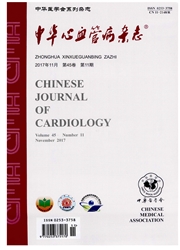

 中文摘要:
中文摘要:
目的探讨美托洛尔剂量调整在治疗置入型心律转复除颤器(ICD)术后电风暴(ES)中的作用。方法回顾性分析119例ICD患者的临床随访资料,Es定义为24h内出现3次或3次以上的室性快速性心律失常(VTA)导致ICD治疗或ICD监测到持续30s以上的VTA,但未发放治疗。结果在(27.5±21.2)个月的随访期内,有39例(32.8%)患者发生Es,平均年龄(52.0±13.1)岁。Es患者中共有9例死亡,存活的30例患者中,25例在Es急性期予去除诱因(5例)、优化ICD工作参数与调整抗心律失常药物(16例)和导管射频消融(4例)后,Es得以控制,另5例Es自行终止。慢性期除2例Brugada综合征患者单用奎尼丁治疗以外,余23例患者将美托洛尔口服剂量由(26.8±13.9)mg/d逐步上调至(88.9±53.5)mg/d后,ES均未再次发作,且VTA发生次数较剂量调整前显著减少[(1.9±1.7)次/月与(0.8±0.6)次/月,P=0.004]。另16.7%(5/30)的患者美托洛尔日剂量需上调至平均(255.3±41.7)mg时,ES才得以控制。结论在治疗ICD术后ES时,美托洛尔应个体化足量使用,约1/6的患者日剂量需要超过200mg。
 英文摘要:
英文摘要:
Objective To explore the effectiveness of the metoprolol dosage adjustment on reducing the incidence of electrical-storm ( ES ) in patients with Implantable Cardioverter Defibrillators ( ICDs ). Methods Data from patients with ICD implantation between Jan, 2003 and Jun, 2006 in our hospital were retrospectively analyzed. ES was defined as either ≥ 3 times of ventricular tachyarrhythmias (VTAs) resulting in ICD therapy or VTAs lasting more than 30 s detected by ICD without any therapy within 24 hours. Results During a follow-up period of ( 27.5 ± 21.2 ) months, ES was recorded in 39 cases [ 34 males, average age (52. 0± 13.1 ) years ] out of 119 patients (32. 8% ) and 9 patients died after ES. During the period of storm attack, ES was successfully controlled in 25/30 patients by various interventions, including predisposing factors corrected in 5 cases, ICD reprogramming and antiarrhythmic drugs therapy optimized in 16 cases (one received intravenous injection of metoprolol), and VTAs eliminated by catheter ablation in 4 cases. ES was spontaneously resolved in the remaining 5 cases. In the chronic phase, 2 patients with Brugada syndrome were treated with Quinidine mono-therapy while the dosage of metoprolol was adjusted in the remaining 23 patients and the dosage of metoprolol was increased gradually from (26. 8 ± 13.9)mg/d to (88. 9 ±53.5) mg/d without any adverse effects (9 patients received also oral amiodarone 200 mg/d). Post dosage adjustment, the total VTA episodes [ ( 1.9 ± 1.7 ) times/month vs. ( 0. 8± 0. 6) times/month, P = 0. 004 ], incidence of antitachycardia pacing therapies [ ( 4. 2± 3.8 ) runs/month vs. (2. 3 ± 2.0) runs/month, P = 0. 003 ], as well as electrical cardioversion or defibrillation [ ( 1.1 ± 0. 9 ) times/month vs. (0.4±0. 2)times/month,P =0. 001 ] were significantly decreased. ES was not controlled until a extremely high dosage [ 225 -300 (255.3± 41.7 )mg/d ] of metoprolol was reached in the remaining 5 pat
 同期刊论文项目
同期刊论文项目
 同项目期刊论文
同项目期刊论文
 期刊信息
期刊信息
